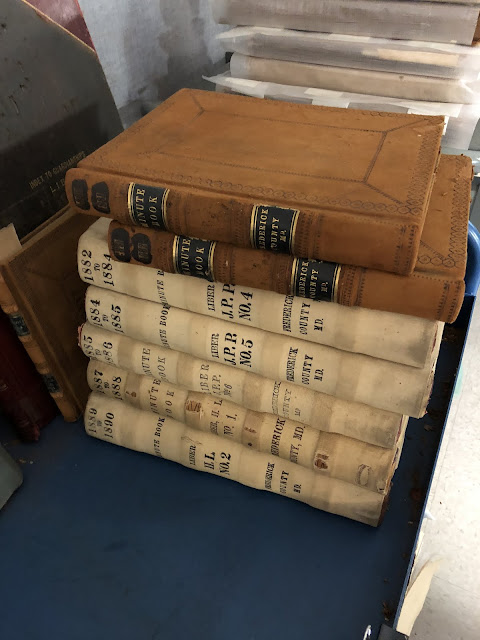No. 22
Note: You can do a Google search for "A Family History Mission" to see all the previous posts in this ongoing series. You can also search for "James Tanner genealogy" and find them.
One of the tasks we encounter at the Maryland State Archives is preparing the documents for digitization. These are Court Proceedings, primarily probate, guardianship and other court records, from the early 1800s. Our task is to sort and partially waypoint these documents and open them up so they are flat and can be scanned. The paper is in surprisingly good shape. The real challenge is the handwriting.
This particular record happens to be an Indenture contract. A young boy, with the permission of his father, is being "indentured" to another person for a period of three years. The document does not say how old the boy was, but he was likely between 12 and 14 years of age but could have been younger. For all practical purposes, the indentured servant was a slave for a term of years.
The handwriting above is typical of the early 1800s. It is not easily readable unless you have become accustomed to reading it. Reading old handwriting is a skill that is obtained by simply working at learning the styles and letterforms combined with a lot of practice. This document is essentially a contract between the boy's father and the potential "owner" of the indentured servant.
Here is another example. This is a more formal court hand used in a probate accounting report.
There are a number of letterforms that are now out of style. Of course, today, except for those involved in formal calligraphy, handwriting is quite dead. You should take note of the signature at the bottom of the document.
Here is another example of a probate accounting. This is lovely enough to frame and put on your wall.
The brown color of the ink results in the fading of the old black ink and its interaction with the paper. The degree to which the ink changes color and fades depends on the particular formulation of the ink and the conditions of storage. These documents are in excellent condition and the digitization process will preserve images of them for far longer than they will remain legible even under ideal storage conditions.
The handwriting above is typical of the early 1800s. It is not easily readable unless you have become accustomed to reading it. Reading old handwriting is a skill that is obtained by simply working at learning the styles and letterforms combined with a lot of practice. This document is essentially a contract between the boy's father and the potential "owner" of the indentured servant.
Here is another example. This is a more formal court hand used in a probate accounting report.
There are a number of letterforms that are now out of style. Of course, today, except for those involved in formal calligraphy, handwriting is quite dead. You should take note of the signature at the bottom of the document.
Here is another example of a probate accounting. This is lovely enough to frame and put on your wall.
The brown color of the ink results in the fading of the old black ink and its interaction with the paper. The degree to which the ink changes color and fades depends on the particular formulation of the ink and the conditions of storage. These documents are in excellent condition and the digitization process will preserve images of them for far longer than they will remain legible even under ideal storage conditions.












































